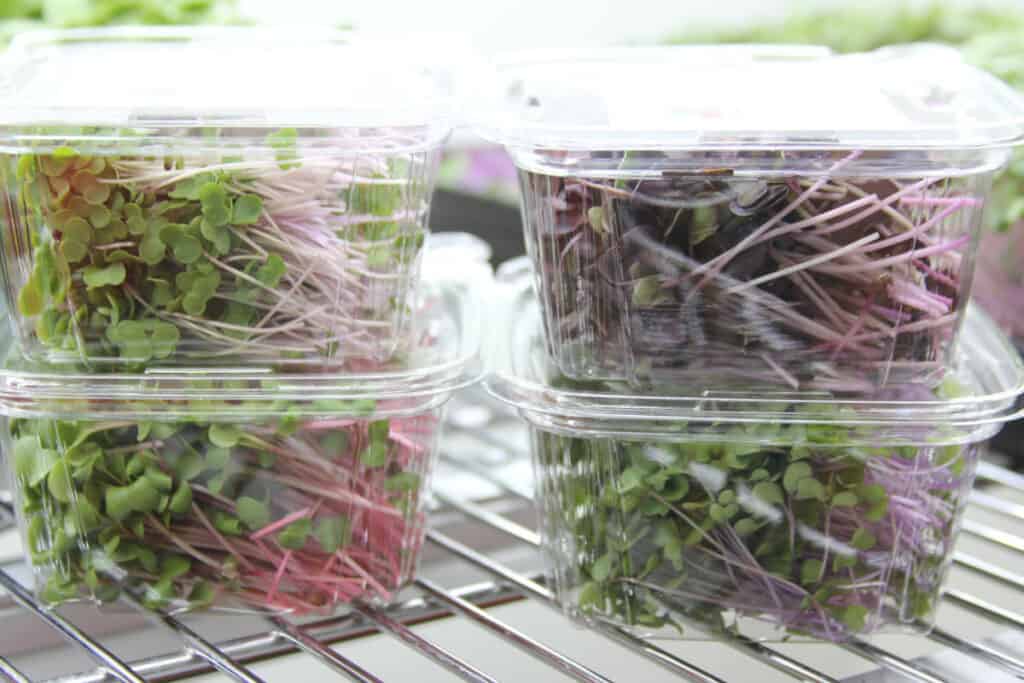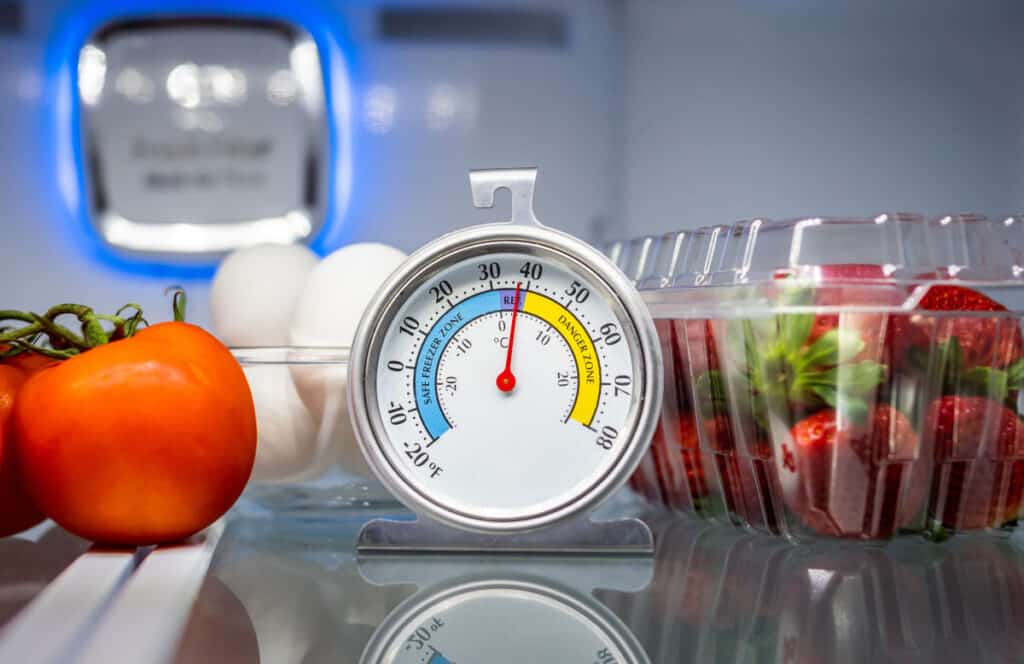Microgreens are different from other vegetables in many ways and they require special handling in order to maintain their freshness and flavor. How you store your microgreens can make a difference in how long they last.
So how to store microgreens? In short, they need to be in an airtight container and kept in the cold and dark refrigerator. This can lengthen the shelf-life of microgreens and preserve more of their freshness, nutrition and flavor.
Microgreens are very vulnerable during growing, harvesting and storing. They are sensitive to temperatures, humidity, as well as over and under-watering. They are basically baby plants that need tender loving care. They need to be protected from the harshness of the elements of rain, wind, and strong sun as well as pathogens.
So the same is true for microgreens in transport and storage. Some microgreens are sturdier than others and some naturally will last longer. Peas for example last longer than broccoli. This may have to do with their size and harder stems and leaves. Smaller microgreens tend to be softer and they get crushed more easily if not stored properly. In any case, they should last from one to two weeks depending on the variety.
In order for the microgreens to achieve their maximum shelf life, they need to be harvested and chilled right away. So shelf life will also depend on how the microgreens were harvested and packaged. After they have been cut, they need to be put in a cold place as soon as possible.
If you buy your microgreens in the grocery store, they may not have the ideal conditions for storing microgreens. These shelves are most likely not cold enough and definitely not dark. So most grocery store microgreens will have a shorter shelf life. Now let’s look at some of the storage factors and how they affect the quality of your microgreens.
Dry Microgreens Last Longer
One of the most important factors that will influence the shelf life of microgreens is how dry or wet they are. Wet microgreens don’t last very long in the fridge. They become mushy within a few days. That’s why it’s important to store your microgreens dry. For this reason, many growers don’t wash the microgreens before they sell them. If they do, they spin them and dry them to make sure they package them dry. They also have to be careful not to dehydrate them too much, so this is another delicate process that takes practice.
For this reason, it’s best to wash your microgreens right before you use them. So only wash the amount you are going to use right away, and store the rest dry in the fridge. Here is an article about why you need to wash your microgreens and how.
The reason why dry microgreens last longer is because moisture encourages the growth of pathogens, such as mold and bacteria, and microgreens are especially sensitive to contamination. Mold and bacteria can be found in the air and the soil, and there may be some residue on the plants, which is perfectly normal. But excessive moisture make these microorganism multiply faster. This is one reason why you need to wash your microgreens before you eat them, so that you don’t ingest any of these organisms.
Sturdy Airtight Packaging Protects Your Microgreens Best

Microgreens are most often packaged in plastic bags or hard plastic containers called clamshells. They can both provide protection against drying out. The main difference is the protection the hard containers provide agains crushing. Microgreens in a plastic bag can get crushed during transportation and storage, and in your fridge if you accidentally push something else on top of it.
If you are growing your own microgreens, you can store them in reusable plastic containers that have a tight-sealing lid. In addition, if you buy your microgreens in plastic bags, you can transfer them to hard plastic containers when you put them in the fridge.
Glass containers also work well, if you don’t keep the microgreens there for longer than a week. Glass containers create more condensation, which can negatively impact the quality.
Low Temperature Storage Reduces Quality Loss and Extends Shelf Life

Microgreens are sensitive to temperatures, and once they are harvested, they need to be stored in the refrigerator. According to this 2013 study by Zhenlei Xiao, the ideal temperature for storing radish microgreens was 1 degree Celsius, or 34 degrees Fahrenheit. At this temperature, the chlorophyll content of the microgreens barely decreased even after 14 days. When the radish microgreens were stored at 10 Celsius (50 Fahrenheit), however, they started to show signs of yellowing on day 7.
In addition, the study found that “storage temperatures significantly affected microbial growth rate.” Low temperature storage significantly inhibited the growth of mold and bacteria.
That ideal storage temperature is just above freezing, so you need to make sure you find the coldest spot in the fridge but don’t freeze the microgreens. If you measure the temperature inside your fridge on different shelves, you can get very different results. In my fridge, the top shelf can get so cold that some of the things freeze, while the lower shelves are fine. So you need to find the spot that is cold, but there is no danger of the microgreens freezing. Microgreens are too delicate to handle freezing, so unfortunately freezing them is not an option.
Light Exposure Accelerates Deterioration
Most produce, including microgreens, is displayed on well-lit shelves in supermarkets. Although this is the most convenient for both retailers and shoppers, it’s not the best solution for microgreens, which already have a shorter shelf life than other produce.
The same study we mentioned above also investigated the effect of light exposure on the shelf life of microgreens and concluded that “light exposure accelerated deterioration of radish microgreens, while dark storage maintained quality.”
This poses a problem for microgreen growers who would like to sell their microgreens to retail stores, since customers are less likely to buy wilting microgreens. This is one of the reasons while many growers would rather sell directly to customers through farmers markets and CSA programs.
Humidity Affects Microgreen Quality
One of the reasons why we use air-tight containers is because microgreens can dry out easily in the refrigerator. Leafy greens and microgreens need higher humidity than some other produce, otherwise they will wilt. On the other hand, if there is too much moisture in the container, the microgreens can start rotting. This is why it’s important to store them dry. Still, there could be some moisture as the microgreens “perspire.” You can add a piece of paper towel in the container that will absorb access moisture.
Some growers use containers with small perforations so that the microgreens can breathe. This can also work if the fridge is not too dry. So you will have to determine the humidity levels of your refrigerator to see what works best for you.
Shelf Life Depends on Microgreen Variety
How long a microgreen will last also depends on the variety. In my experience, the smaller the microgreen the shorter its shelf life. Broccoli, cabbage and kale will easily last a week. Radish can easily last longer. And peas can last for two weeks.
Summary
As you see, there are many factors that influence the shelf life of microgreens and how long your microgreens last will depend on the combination of these factors. Harvesting and washing techniques, packaging, and storage conditions all contribute. If your microgreens look slimy and smell bad, it’s best to discard them.
In summary, if you would like to extend the shelf life of your microgreens, follow these steps for best results:
- Store your microgreens dry.
- Keep you microgreens just above freezing temperatures, preferably below 40 Fahrenheit or 5 Celsius.
- Store your microgreens in an airtight container.
- Place a piece of paper tower in the bottom of the container to control humidity.
- Wash your microgreens just before you use them and consume them the same day.



Leave a Reply